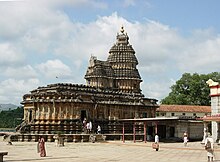|
Daśanāmi Sampradaya
The Daśanāmi Sampradaya (IAST: Daśanāmī Saṃpradāya "Tradition of Ten Names"), also known as the Order of Swamis,[1] is a Hindu monastic tradition of "single-staff renunciation" (ēka daṇḍi saṃnyāsī)[2][3][4] Ēkadandis were already known during what is sometimes referred to as "Golden Age of Hinduism" (ca. 320-650 CE).[5] According to hagiographies composed in the 14th-17th century, the Daśanāmi Sampradaya was established by Vedic scholar and teacher Adi Shankaracharya (9th cent. CE), organizing a section of the Ekadandi monks under an umbrella grouping of ten names and the four cardinal mathas of the Advaita Vedanta tradition.[web 1] However, the association of the Dasanāmis with the Shankara maṭhas remained nominal.[web 1] Ēkadaṇḍis Ēkadandis were already known during what is sometimes referred to as "Golden Age of Hinduism" (ca. 320-650 CE).[5] The Ēkadaṇḍis existed in the Tamil speaking area during the southern-Indian Pandyan dynasty (3rd century BCE - 16th century CE) and the Southern-Indian Pallava dynasty (2nd - 9th centuries CE). Being wandering monastics, they were not settled in the brahmadeyas or settlement areas for Brahmins. There existed tax free bhiksha-bogams for feeding the Ēkadaṇḍi ascetics in the ancient Tamil speaking territory.[6] Ēkadaṇḍis and Tridandis were also active in Eastern India, and appear to have existed there during the Northern-Indian Gupta Empire (320 to 550 CE ).[7] According to R. Tirumalai, "There appears to have been no sectarian segregation of the Shaiva (Ēkadaṇḍi) and Srivaishnava (Tridandi Sannyāsins)".[8] Professor Kiyokazu Okita and Indologist B. N. K. Sharma says, Sannyasis in the lineage of Advaita of Adi Shankara and the Sannyasis in the lineage of Dvaita of Madhvacharya are all Ēkadaṇḍis.[9] Establishment of the Dasanami Sampradaya According to tradition, Adi Shankara (9th cent. CE) established the Dasanami Sampradaya. Shankara came to be presented as an incarnation of Shiva in the 14th century,[10][web 1] to facilitate the adoption of his teachings by previously Saiva-oriented mathas in the Vijayanagara Empire. From the 14th century onwards hagiographies were composed, in which he is portrayed as establishing the Daśanāmi Sampradaya,[11] organizing a section of the Ekadandi monks under an umbrella grouping of ten names.[web 1] Several other Hindu monastic and Ekadandi traditions remained outside the organisation of the Dasanāmis.[12][13][14] According to these hagiographies, Adi Shankara organized the Hindu monastics of these ten sects or names under four maṭhas or monasteries, with headquarters at Dvārakā in the west, Jagannathadham Puri in the east, Sringeri in the south and Badrikashrama in the north.[web 1] Each maṭha was headed by one of his four main disciples, who each continued the Vedanta Sampradaya. Monastics of these ten orders differ in part in their beliefs and practices, and a section of them is not considered to be restricted to specific changes made by Shankara. While the Dasanāmis associated with the Shankara maṭhas follow the procedures enumerated by Adi Śankara, some of these orders remained partly or fully independent in their belief and practices; and outside the official control of the Shankara maṭhas. The association of the Dasanāmis with the Smarta tradition or Advaita Vedānta is not all-embracing. One example is the Kriyā Yoga tradition that considers itself eclectic (see: Eclecticism), with ancient[web 2] unchangeable beliefs, and outside the ambit of differences in the understanding of Vedanta. Other examples are the Tantric Avadhūta Sampradāyas and Ekadaṇḍi sannyāsa traditions outside the control of the Shankara maṭhas.[14] The Dasanāmis or Ēkadaṇḍis also founded, and continue to found or affiliate themselves with, maṭhas, ashrams and temples outside the control of the Shankara maṭhas.[web 2][web 3] The Advaita Sampradāya is not a Shaiva sect,[web 1][15] despite the historical links with Shaivism:
Nevertheless, contemporary Shankaracaryas have more influence among Saiva communities than among Vaisnava communities.[web 1] The greatest influence of the gurus of the Advaita tradition has been among followers of the Smartha tradition, who integrate the domestic Vedic ritual with devotional aspects of Hinduism.[web 1] According to Nakamura, these maṭhas contributed to the influence of Shankara, which was "due to institutional factors".[16] The maṭhas which he built exist until today, and preserve the teachings and influence of Shankara, "while the writings of other scholars before him came to be forgotten with the passage of time".[17] The table below gives an overview of the four Amnaya maṭhas founded by Adi Shankara, and their details.[web 4]
Expansion of the Dasanāmi SampradāyaAccording to the tradition in Kerala, after Shankara's samādhi at Vadakkunnathan Temple, his disciples founded four maṭhas in Thrissur, namely Naduvil Madhom, Thekke Madhom, Idayil Madhom and Vadakke Madhom. According to Pandey, the ēkadaṇḍis or Dasanāmis had established monasteries in India and Nepal in the 13th and 14th century.[web 5] Naga Sadhus akharas
 In the 16th century, Madhusudana Saraswati of Bengal organised a section of the Naga (naked) tradition of armed sannyasis in order to protect Hindus from the tyranny of the Mughal rulers. Warrior-ascetics could be found in Hinduism from at least the 1500s and as late as the 1700s,[18] although tradition attributes their creation to Sankaracharya.[web 6] Some examples of Akhara currently are the Juna Akhara of the Dashanami Naga, Niranjani Akhara, Anand Akhara, Atal Akhara, Awahan Akhara, Agni Akhara and Nirmal Panchayati Akhara at Prayagraj.[web 7] Each akhara is divided into sub-branches and traditions. An example is the Dattatreya Akhara (Ujjain) of the naked sadhus of Juna Naga establishment.[web 8] The naga sadhus generally remain in the ambit of non-violence presently, though some sections are also known to practice the sport of Indian wrestling. The Dasanāmi sannyāsins practice the Vedic and yogic Yama principles of ahimsā (non-violence), satya (truth), asteya (non-stealing), aparigraha (non-covetousness) and brahmacārya (celibacy / moderation). The naga sadhus are prominent at Kumbh mela, where the order in which they enter the water is fixed by tradition. After the Juna akhara, the Niranjani and Mahanirvani Akhara proceed to their bath. Ramakrishna Math Sevashram are almost the last in the procession.[web 9] CharacteristicsParamparaIn the Indian religious and philosophical traditions, all knowledge is traced back to the gods and to the Rishis who primarily heard the Vedas by meditation. The current Acaryas, the heads of the maṭhas, trace their authority back to the four main disciples of Shankara,[web 10] and each of the heads of these four maṭhas takes the title of Shankaracharya ("the learned Shankara") after Adi Shankara.[citation needed] The Advaita guru-paramparā (Lineage of Gurus in Non-dualism) begins with the mythological time of the Daiva-paramparā, followed by the vedic seers of the Ṛṣi-paramparā, and the Mānava-paramparā of historical times and personalities:[web 10][note 1]
Ten NamesHindus who enter sannyāsa in the ēkadaṇḍi tradition take up one of the ten names associated with this Sampradaya: Giri, Puri, Bhāratī, Vana/Ban, Āraṇya, Sagara, Āśrama, Sarasvatī, Tīrtha, and Parvata.[web 12][web 1] Sanyasis of Advaita Vedanta and Dvaita Vedanta belong to ēkadaṇḍi tradition.[20] One thing to be noted, the surname "Natha" is not given to dashnami sanyasis, this title is given to Natha Yogis who take sanyasa under the tradition of Natha Shaivism, which, is very close to the Siddhanta of Advaita Vedanta's monism. Swami'sA swami, as the monk is called, is a renunciate who seeks to achieve spiritual union with the swa (Self). In formally renouncing the world, he or she generally wears ochre, saffron or orange-colored robes as a symbol of non-attachment to worldly desires, and may choose to roam independently or join an ashram or other spiritual organizations, typically in an ideal of selfless service.[1] Upon initiation, which can only be done by another existing Swami, the renunciate receives a new name (usually ending in ananda, meaning 'supreme bliss') and takes a title which formalizes his connection with one of the ten subdivisions of the Swami Order. A swami's name has a dual significance, representing the attainment of supreme bliss through some divine quality or state (i.e. love, wisdom, service, yoga), and through a harmony with the infinite vastness of nature, expressed in one of the ten subdivision names: Giri (mountain), Puri (tract), Bhāratī (land), Vana (forest), Āraṇya (forest), Sagara (sea), Āśrama (spiritual exertion), Sarasvatī (wisdom of nature), Tīrtha (place of pilgrimage), and Parvata (mountain). A swami is not necessarily a yogi, although many swamis can and do practice yoga as a means of spiritual liberation; experienced swamis may also take disciples.[1] Single-staff renunciates are distinct in their practices from Shaiva trishuladhari or "trident-wielding renunciates" and Vaishnava traditions of Tridandi sannyāsis.[21][note 3][note 4] Standardised List of Dasanāmīs in WikipediaThis section enumerates, in standardised manner, members of the Dasanāmī Order with articles in Wikipedia, listing each under his formal title and name, without the use of the honorifics[note 5] used by devotees and disciples. The word "Swāmī" here is not an honorific. It is the title of an initiated member of the Dasanāmī Order. Entries are listed in standard form: TITLE (Swāmī) + PERSONAL NAME + SUB-ORDER NAME. A few entries have the additional title (not honorific) of "Jagadguru Śankarācārya" which designates either one of the four supreme leaders of the order (somewhat similar to the position of Pope in Catholic Christianity). "Mahanta" is an administrative title designating an organizational position or office assigned to certain persons. A
B
C
D
G
H
I
J
K
L
M
N
O
P
R
S
T
V
Y
Notes
References
Sources
External links |


